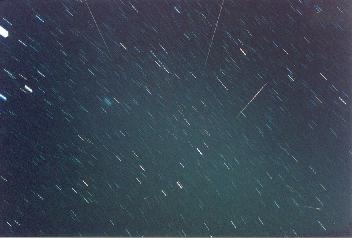
Image courtesy of Dave Glackin
INTRODUCTION
When we think about the space environment we normally think about the flux of electromagnetic energy and subatomic particles that originate from the sun, and modify the interplanetary and near-Earth environment in a multiplicity of ways.
However, a diverse size range of macroscopic particles also travels around the solar system in the interplanetary medium and these may influence the space environment and mankind's systems and activities therein. This particulate flux should be given due consideration by agencies tasked with monitoring and forecasting the space environment.

THE EFFECTS
Historically, the macroscopic particulate flux has been known to us well before we became aware of any other aspects of the space environment. When a small particle enters the Earth's atmosphere, frictional forces heat the surface of the particle to high temperatures producing light (electromagnetic energy) and atmospheric ionization. We call this phenomenon a meteor and the particle that produces it a meteoroid. Both the meteor and the meteoroid contribute to space weather.
The exact behavior and effects of a meteoroid depend very much upon its size. In space, meteoroids constitute a hazard in two ways. Small micron and sub-micron sized particles contribute to the degeneration of highly polished surfaces. Many impacts over a period of time will degrade optical surfaces on remote sensing, early warning and astronomical satellites. Larger particles constitute a collision hazard with the probability of spacecraft penetration increasing with size. Artificial space debris is also of concern of this regard, but natural meteoroids constitute a higher velocity flux with considerably greater kinetic energy.
In the early days of space exploration, much effort was expended to understand the penetration hazard. Fortunately, the danger turned out to be a lot less severe than initially expected. However, it has been pointed out that the threat may increase dramatically during certain years. The Leonid meteor shower, which occurs around Nov 16 each year, increases a thousand fold every 33 years. In 1966 the normal hourly rate of around 5, shot up to 10,000! And in 1999 the Leonid flux was also very large. In fact, some meteor experts predicted that at least one large communications satellite might have suffered serious damage. Fortunately this did not occur, although it is certainly a possibility during times of large meteor storms.
In the Earth's atmosphere, effects are even more varied. Micron sized particles are small enough to radiate sufficient heat during atmospheric entry so that they suffer little ablation until they are reduced to terminal velocity at around the base of the thermosphere (just below 100 km). From there they drift slowly down to the troposphere over a period of months to years. These particles contribute a total annual mass to the Earth of over 10,000 tons.
As the particle size increases, the temperature of the meteoroid will increase and total ablation of the body will occur. The light is visible to observers on the ground and the ionization produced by the ablation process can be used for radio communication. Such communication is done in a high speed burst mode, and is becoming more common for the transmission of remote data from isolated outposts. Communication is normally accomplished at low VHF frequencies and has several interesting advantages. Aspect sensitivity makes the communication relatively private or secure, and this mode is also very robust in the presence of an environment adverse to many other types of communication (eg. nuclear detonations).
There are systems however, that can be adversely affected by significant increases in meteor rates (during meteor showers). One class of systems with such a susceptibility is the HF Doppler radar. These are used in over the horizon radar applications (eg Australian Jindalee OTHR). Meteors show considerable Doppler spread, and can usually be distinguished from other echoes in Doppler-range space. However, a larger than normal influx can increase the overall noise level of the system decreasing its sensitivity, and it can also saturate the signal processing systems. Such degradation may or may not go undetected, depending upon the actual meteor rate increase.
The electromagnetic emission of a meteor is dependent upon the characteristics of the meteor, most strongly on its mass. Typically a mass of 1 gram would produce a visual meteor of around zeroth magnitude. As the mass of the meteoroid increases, so does the amount of infrared and visible energy radiated by the meteor. Bodies in the kilogram range give rise to impressive fireballs. It is quite common at these sizes for the parent body to fragment and/or explode under the extremely high decleration pressures experienced. Early warning satellites may detect these atmospheric entry events, and it is imperative that subsequent signal processing is able to distinguish these from man-made signals.
If the meteoroid mass is on the order of 100 kg or more, then a fraction of the original mass may survive entry, and will drop to the Earth's surface as a meteorite. Most of the initial cosmic velocity (from about 11 to 72 km/sec) will have dissipated by 20 km altitude and the meteorite will fall at terminal velocity of around 100 m/sec. Typically only 1% of the initial mass will land as one or more fragments. Texts on meteors and meteorites used to state that the probability of damage to person or property is so low that no recorded incidents are known. This is not so. In the last decade, three cases of property damage to vehicles has been documented in the USA, and one case of personal injury is known. A research team at the Canadian National Research Council set two criteria for determining possible meteorite falls:
When the initial meteoroid has a mass in excess of about 50 tons, it may possibly survive entry with virtually no reduction in either its velocity or mass. The energy density carried in such a body by virtue of its motion is comparable to the energy released in nuclear processes. A hypervelocity impact crater will invariably result, and substantial damage may occur if the impact is in a populated area. If the body implodes in the atmosphere, even wider area effects may be experienced. Fortunately such impacts are very rare. The actual size at which we can expect a hypervelocity impact versus an airburst will depend very much on the composition of the meteoroid. A small iron type meteoroid will cause a hypervelocity impact at a much smaller size than a meteoroid of cometary compostion. In fact, a body of cometary origin may need to be in excess of 50m in diameter before we see a hypervelocity impact with the ground.
THE ENVIRONMENT
The meteoroid influx into the Earth's space environment is not constant. It varies throughout the day, with the seasons and from year to year. A decade ago, there were almost no continuous monitors for this aspect of space weather. However, the situation is now much improved, with several different types of meteor radar located around the world. Many of these originate from two different companies located in Adelaide, South Australia.
Useful indices or measures of meteor activity vary according the customer affected. Radio users of meteor ionisation tend to perceive a smoother variation of activity than do visual observers. This is because radio signals make use of a meteor population that is created by considerably smaller meteroids than those that are optically visible. Meteor shower phenomena are less apparent in these fainter meteors. Variations of activity for meteor radio systems are most usefully shown by two graphs which display the typical diurnal and annual variations.
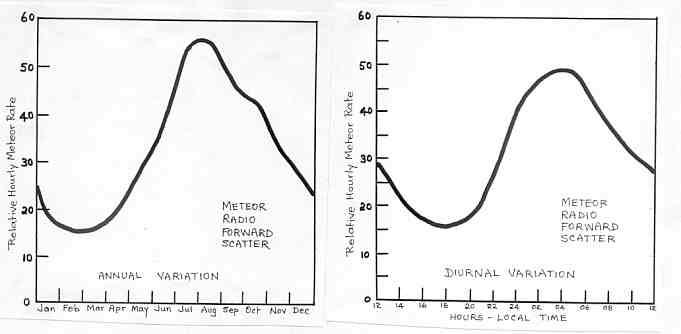
A list of the common meteor streams can be useful to those customers who may be affected by larger meteoroids. It should be pointed out however, that shower rates can be extremely variable, and monitoring the orbital parameters of high rate streams may be worthwhile in the future. It is also certain, although unpredictable, that the Earth will from time to time cross the path of meteroid streams that are so far unknown, or that have been perturbed by planetary fields (mainly Jupiter's gravitational field) into Earth crossing orbits. Following table after McKinley (1961).
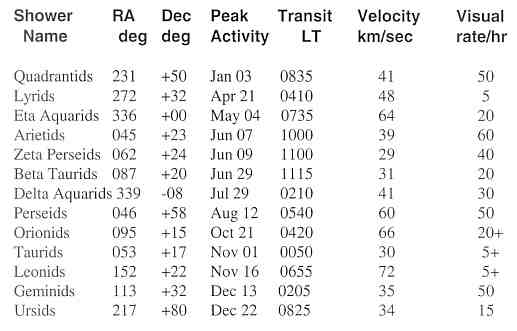
Meteor influx rates in terms of either meteoroid mass or meteor brightness are also useful indices for planning and comparison purposes.
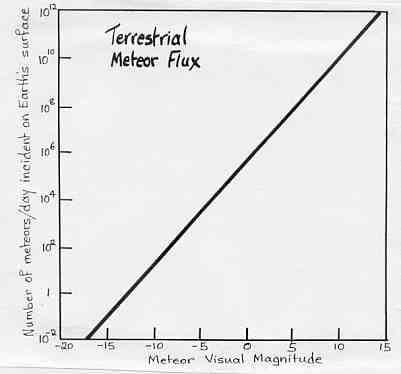
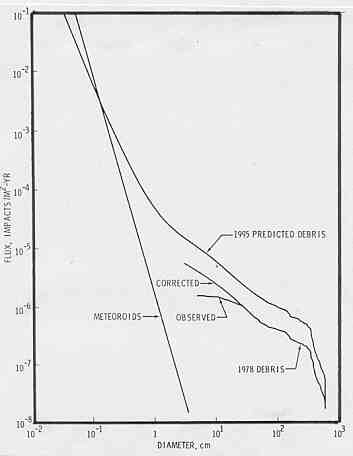
The lower curve shows a comparison of natural meteoroid flux with artificial space debris in low Earth orbit (from Kessler, NASA JSC).
METEOROID ENVIRONMENT SENSORS
Because of the small size and high velocity of meteoroids, it is not possible to detect individual particles prior to an interception. Normally, it is the meteoroid flux that must be targeted. The effects from this component of the space environment are also highly statistical in nature. Either we are concerned with a bulk effect (surface degradation in space), or with the probability of occurrence.
Meteoroid sensors may be placed in space or on the Earth's surface. In space detection usually relies on impact or close encounter with a particle. Penetration of a surface or other instrumental sensitive area is the usual method. However, detection of an electric field change in a near miss situation has also been suggested. The detection rate, however, for all current space sensors is very low because of the limited collection area possible.
A sensor on the ground makes use of the meteor phenomenon to detect incident particles over a collection area of around 1000 square kilometers. Low light optoelectronic, and radio/radar techniques have been used. Forward or backscatter radar can detect large fluxes of very small particles. Automatic processing techniques have been developed for these systems.
Current meteor radar systems employing digital signal processing software on PC type packages will allow for the automatic detection of a meteor echo, and can measure its doppler velocity and direction of arrival.
A METEOROID SPACE ENVIRONMENT SERVICE
A range of customers may be contemplated for a space environment service that is versed not only in electromagnetic and subatomic particles fields in space but which also includes an advice, warning and forecast role in the macro-particles of near-space.
Spacecraft designers need meteoroid flux information in the planning and design phase of both defense and civilian missions. Larger spacecraft, and those with critical exposed surfaces are those most at risk. Satellite and spacecraft operators are likely to be interested in forecasts of excessively high storm activity and to request information to assist in event post analysis.
Meteor burst communication systems require flux information in the planning stages and possibly to a much lesser extent in operations to explain anomalies and manage traffic flow.
HF (eg OTHR) radar operators will be vitally concerned with real-time flux information for anomaly, jamming and interference resolution, and with what predictions are possible in preparation for such events.
Meteorite researchers could well benefit from timely notification of large fireball events (from satellite IR sensors) over land, which might lead to recovery of dropped meteorites. Positional information would be vital in such an application, which may lead to further knowledge of our space environment (a cyclic customer). One example of this is meteorite recovery in the Nullarbor desert of Australia. This has shown that some larger meteoroids tend to cluster in similar orbits over time scales that previously have not appeared feasible from an astronomical or physical viewpoint. Such knowledge may help in the area of planetary defence, which is concerned with the largest macroscopic bodies in the solar system.
General interest customers from the astronomical community and the lay public could help further public relations and support for space environmental monitoring. Knowledge transfer of the space environment could be supplemented with large event notification that has attracted community interest.
A space environmental service supporting macro-particulate fluxes will require appropriate sensor inputs, an archive of data and climatology, and could be expected to provide real-time information on meteoroid influx, forecasts of storm events, and general consultation services.
Probably the best sensor system to support real-time flux is one or more ground-based meteor radars with automated detection and analysis. This could be supplemented by satellite global IR sensors for large mass events. Computer orbital evolution analysis would be necessary to forecast meteor storm periods.
Computer accessible databases should include influx climatology, large event lists, meteor stream orbital elements and environmental effects of large flux and single event occurrences.
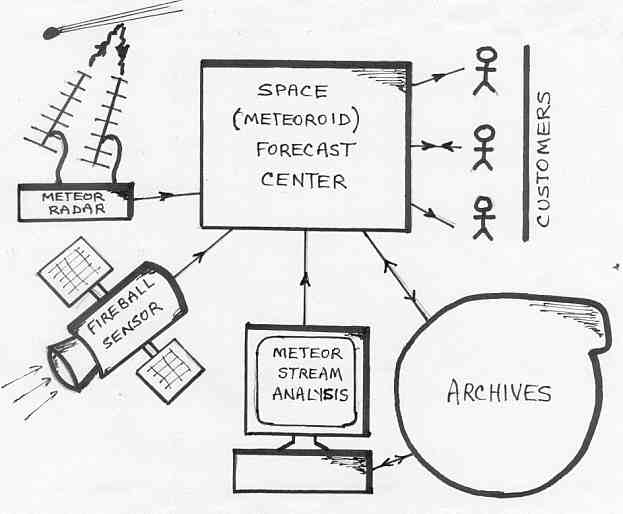

THE METEOROID ENVIRONMENT - EFFECTS
ON EARTH

THE METEOROID ENVIRONMENT - CUSTOMERS

A METEOROID ENVIRONMENT SERVICE
INPUTS
ARCHIVES
OUTPUTS

 Australian Space Academy
Australian Space Academy